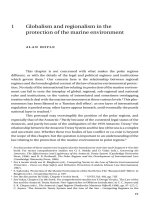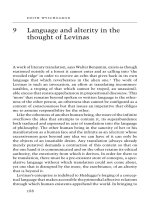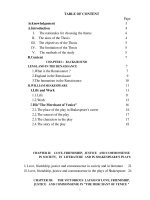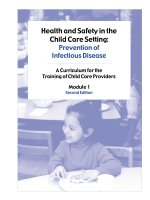ANTIBIOTIC RESISTANCE OF ESCHERICHIA COLI ISOLATED FORM POULTRY WORKERS, PATIENTS AND CHICKEN IN THE EASTERN PROVINCE OF SAUDI ARABIA ppt
Bạn đang xem bản rút gọn của tài liệu. Xem và tải ngay bản đầy đủ của tài liệu tại đây (139.77 KB, 6 trang )
Tropical Medicine and International Health
volume 4 no 4 pp 278–283 april 1999
© 1999 Blackwell Science Ltd
278
Antibiotic resistance of Escherichia coli isolated from poultry
workers, patients and chicken in the eastern province of Saudi
Arabia
Mastour S. Al-Ghamdi
1
, Fikry El-Morsy
2
, Zaki H. Al-Mustafa
1
, Mustafa Al-Ramadhan
3
and Mohammad Hanif
4
1 Department of Pharmacology, College of Medicine, King Faisal University
2 Department of Microbiology, College of Medicine, King Faisal University
3 College of Veterinary Medicine, King Faisal University
4 Department of Family and Community Medicine, College of Medicine, King Faisal University, Saudi Arabia
Summary The prevalence of antibiotic-resistant Escherichia coli isolates from faecal samples from 117 poultry industry
workers, 100 patients and119 healthy chicken were compared. Resistance of E. coli chicken isolates to ampi-
cillin, chloramphenicol, gentamicin, spectinomycin, tetracycline and trimethoprim ϩ sulphamethoxazole
(TMP ϩ SMX) (range 57% – 99.1%) were significantly higher than those isolated from patients (range
21.9% – 71.4%) and workers (range 35% – 71.8%). However, for drugs not used in poultry, such as amoxi-
cillin ϩ cluvalanate (AMX ϩ CLV), ceftazidime and nitrofurantoin, resistance rates of chicken isolates
(range 0% – 2.6%) were significantly lower than those of patient isolates (range 8.7% – 30%). Resistance to
spectinomycin reached 96% in E. coli chicken isolates and 71% in organisms isolated from humans. Use of
this drug in Saudi Arabia is mostly limited to veterinary purposes. Multidrug resistance is alarmingly high in
all groups but was highest in chicken isolates (77.4%). Serotyping of E. coli isolates showed that 27% of the
organisms isolated from patients were overlapping with 10.9% of the chicken isolates, indicating the possi-
bility of chicken being a source of the resistance pool for humans. We therefore call for the banning of
antibiotics in the poultry industry as growth promoters and recommend that their use be restricted to treat-
ing infections.
keywords Escherichia coli, microbial, antibiotics, antibiotic resistance, poultry, Saudi Arabia.
correspondence Dr Mastour Al-Ghamdi, Department of Pharmacology, College of Medicine, King Faisal
University, PO Box 2114, Dammam 31451, Saudi Arabia
Introduction
Antibiotics are widely used in poultry production as growth
promoters or to control infectious disease. This practice is
reported to have caused high resistance to antimicrobial
agents in normal chicken flora (Swan Report 1969; Smith
1974; Aronson 1975; Linton 1977; Allan et al. 1993) and path-
ogenic organisms (Amara et al. 1995). These resistant micro-
organisms may act as a possible source for the transfer of
antimicrobial resistance to human pathogens (Bebora et al.
1994). Plasmid and transpon-mediated resistance is widely
transmitted between different bacterial species and genera
including human pathogens (Wise et al. 1985; Davies 1994).
Multidrug-resistant strains of E. coli are prevalent in both
human and animal isolates in different parts of the world
(Mahipal et al. 1992; Bebora et al. 1994; Amara et al. 1995).
E. coli is a common normal flora organism in the gastro-
intestinal tract of animals and man (Jawetz et al. 1984) but
may become pathogenic to both (Jacobs et al. 1970; Marier
et al. 1973; Burkhanova 1980; Levine 1987). Serious outbreaks
of gastrointestinal illness caused by foodborne pathogenic
E. coli, especially 0157:H7, have occurred during the past two
decades (Armstrong et al. 1996). Thus, resistant strains of
E. coli arising from the exposure of animals to antimicrobials
may possibly become infectious organisms in humans.
Antimicrobial agents are widely used in the poultry indus-
try of Saudi Arabia. In fact, our own survey showed that 28
antimicrobial agents were available for poultry use in the
Eastern Province of Saudi Arabia. These include – lactams,
tetracyclines, aminoglycosides, macrolides, fluoroquinolones,
TMIH392
Tropical Medicine and International Health volume 4 no 4 pp 278–283 april 1999
M. S. Al-Ghamdi et al. E. Coli antibiotic resistance in Saudi Arabia
© 1999 Blackwell Science Ltd
279
linconasomides and sulphonamides. They are mainly added,
often concomitantly, to drinking water for infection prophy-
laxis. Twenty of these antimicrobial agents are also com-
monly used in the treatment of human infections. However,
no study was so far conducted in Saudi Arabia to evaluate
resistance to antibiotics in poultry and its possible impact on
human health.
Our aims were to investigate and compare the patterns of
resistance of E. coli isolated from poultry industry workers,
patients and chicken, and to identify the common serotypes
of E. coli isolated from humans and poultry.
Materials and methods
The susceptibility patterns of 119, 117 and 100 E. coli organ-
isms isolated from live healthy chicken in local slaughter
shops, poultry industry workers and patients in King Fahd
Hospital of the University, Al-Khobar, Saudi Arabia, respect-
ively, were determined. Specimens were directly inoculated on
MacConkey agar, eosin methylene blue and xylose lysine des-
oxycholate agar media and growth was identified by standard
laboratory methods including Gram stain and API system
(BioMerieux SA, Marcy Etoile, France). The Bauer-Kirby disc
diffusion method (Bauer et al. 1966) was used to test suscepti-
bility of the isolated organisms to ampicillin (10 g), amoxi-
cillin ϩ clavulanic acid (AMX ϩ CLV) (Augmentin, 30 g),
ceftazidime (75 g), chloramphenicol (30 g), tetracycline
(30 g), gentamicin (10 g), spectinomycin (10 g), tri-
methoprim ϩ sulphamethoxazole (TMP ϩ SMX) (Septrin,
25 g) and nitrofurantoin (100 g). All antibiotic discs were
obtained from Oxoid (Unipath Ltd, Basingstoke, UK).
Interpretation followed criteria recommended in the National
Committee for Clinical Laboratory Standards (NCCLS 1993).
In addition, E. coli organisms isolated from chicken and
patients were serotyped using E. coli antisera (Denken Seiken,
Tokyo, Japan).
All data were recorded and analysed using SPSS/PC soft-
ware. Results were statistically analysed using the Spearman
correlation coefficient test and Student’s t-test, with a signifi-
cance level of P Ͻ 0.05.
Results
The susceptibility of E. coli isolates from chicken and
patients to the tested antibiotics is summarised in Table 1.
The highest resistance rate observed in the chicken E. coli
isolates was to tetracycline (99.1%) followed by those to
spectinomycin (95.7%), TMP ϩ SMX (92.2%), gentamicin
(89.7%), ampicillin (88.7%) and chloramphenicol (57.0%).
AMX ϩ CLV, ceftazidime and nitrofurantoin remained
highly effective with resistance rates Յ 2.6%. The highest
rate of resistance in E. coli isolated from patients was to
spectinomycin (71.4%), followed by ampicillin (70.7%), tetra-
cycline (64.7%), TMP ϩ SMX (46.3%) and AMX ϩ CLV
(30.0%).
Moderate or low resistance rates were noted with cef-
tazidime, nitrofurantoin and gentamicin. Both groups showed
similar patterns of resistance to the tested antibiotics, with a
Spearman correlation coefficient of 0.7448 (P ϭ 0.021).
However, resistance rates to individual drugs in E. coli iso-
lated from patients remained significantly lower than those of
E. coli chicken isolates with the exception of resistance to cef-
tazidime, AMX and nitrofurantoin (Table 1).
The Spearman test also revealed a highly significant corre-
lation (coefficient ϭ 0.9289, P ϭ 0.000) between the resist-
ance pattern of E. coli isolated from poultry industry workers
and E. coli isolated from chicken (Table 2). However, despite
the similarity of resistance patterns to the tested antibiotics in
E. coli-chicken E. coli-patient
isolates isolates t-test
No. % No. %
Drugs tested resistance tested resistance P-value Significance
Ampicillin 115 88.7 99 70.7 0.0002 S
AMXϩCLV 116 02.60 99 30.0 0.0002 S
Ceftazidime 114 00.0 92 08.70 – NA
Chloramphenicol 113 57.0 92 28.3 0.0001 S
Tetracycline 116 99.1 99 64.7 0.0000 S
Gentamicin 116 89.7 96 21.9 0.0001 S
Spectinomycin 116 95.7 91 71.4 0.0000 S
TMPϩSMX 116 92.2 95 46.3 0.0000 S
Nitrofurantoin 116 02.6 74 10.8 0.0456 S
S, Significant; NA, Not applicable. Spearman Correlation coefficient ϭ 0.7448, P ϭ 0.021
Table 1 Comparison of pattern of
resistance of E. coli isolates from
chicken and patients
Tropical Medicine and International Health volume 4 no 4 pp 278–283 april 1999
M. S. Al-Ghamdi et al. E. Coli antibiotic resistance in Saudi Arabia
© 1999 Blackwell Science Ltd
280
both groups, resistance rates remained significantly lower in
E. coli isolated from the workers than those from chicken.
Multidrug resistance rates of E. coli organisms isolated
from chicken were significantly greater than those of patient
isolates (Table 3). This became more evident when comparing
the rates of resistance to four drugs or more in both groups
(78.3% and 77.4% against 8.8% and 7.7%, respectively). In
addition, 20.5% of E. coli organisms isolated from workers
were multiply resistant to the same drugs, which was also sig-
nificantly (P ϭ 0.0124) more than in patients’ isolates.
Serotyping of 119 and 100 E. coli organisms isolated from
chicken and patients, respectively, is presented in Table 4.
Only 30.3% of chicken E. coli isolates and 38% of patient
isolates were serotypeable. Twenty-one serotypes were found
among E. coli isolated from chicken, most commonly 0114
(6 isolates), 06 (4 isolates) and 01 (3 isolates). There were 15
serotypes in human E. coli isolates with 06 (14 isolates), 027
(6 isolates) and 018 (3 isolates) being the most common ones.
Seven serotypes (01, 06, 08, 015, 027, 0119 and 0167) were
found in both groups. These represent 10.9% of the poultry
E. coli isolates and 27% of the E. coli isolated from patients
(Table 4).
Discussion
We investigated the resistance of E. coli isolated from poultry
industry workers and patients to 9 antimicrobial agents
commonly used in the poultry industry and/or for patients in
E. coli-chicken E. coli-patient
isolates isolates t-test
————————— ————————— —————————–
No. % No. %
Drugs tested resistance tested resistance P-value Significance
Ampicillin 115 88.7 117 53.8 0.0000 S
AMXϩCLV 116 02.60 117 05.1 0.4472 NS
Ceftazidime 114 00.0 117 00.0 – NA
Chloramphenicol 113 57.0 117 35.0 0.0006 S
Tetracycline 116 99.1 117 58.1 0.0000 S
Gentamicin 116 89.7 117 37.6 0.0000 S
Spectinomycin 116 95.7 117 71.8 0.0000 S
TMPϩSMX 116 92.2 117 53.0 0.0000 S
Nitrofurantoin 116 02.6 117 06.0 0.2892 NS
S, Significant; NA, Not applicable; NS, Not significant. Spearman Correlation coefficient
ϭ 0.9289, P ϭ 0.000
E. coli-chicken E. coli-patient t-test
———————– ———————– ———————–—–
No. % No. %
Drugs tested resistance tested resistance P-value Significance
Ampicillin, chloramphenicol 113 49.6 92 20.6 0.0000 S
Ampicillin, gentamicin 115 82.6 96 16.7 0.0000 S
Ampicillin, spectinomycin 115 88.7 91 48.4 0.0000 S
Ampicillin, tetracycline 115 89.6 99 55.6 0.0000 S
Ampicillin, TMPϩSMX 115 85.2 94 43.6 0.0000 S
Ampicillin, gentamicin, 115 78.3 91 08.8 0.0000 S
tetracycline & TMPϩSMX
Ampicillin, gentamicin, 115 77.4 91 07.7 0.0000 S
spectinomycin, tetracycline &
TMPϩSMX
S, Significant
Table 2 Comparison of pattern of
resistance of E. coli isolates from
chicken and laborers
Table 3 Comparison of multi-resistance
of E. coli-chicken isolates and E. coli-
patients isolates
Tropical Medicine and International Health volume 4 no 4 pp 278–283 april 1999
M. S. Al-Ghamdi et al. E. Coli antibiotic resistance in Saudi Arabia
Van-den-Bogaard and Stobberingh (1996) recently called for
banning the use of antibiotics as growth promoters in ani-
mals in the Netherlands.
Spectinomycin is an aminocyclitol compound related struc-
turally to aminoglycosides and used by veterinarians as a
broad spectrum antibiotic against gram negative bacteria
including E. coli, Klebsiella, Salmonella, Proteus and
Enterobacter organisms (Allen et al. 1993). E. coli organisms
isolated from chicken were almost totally resistant to tetra-
cycline and spectinomycin. This might be explained by the
fact that both are heavily used in the poultry industry in
Saudi Arabia and could be the result of misuse or antagonism
effect between the two drugs, especially when used concur-
rently (Allen et al. 1993). High resistance rates were also
noted with TMP ϩ SMX and chloramphenicol in E. coli iso-
lated from poultry despite the fact that the latter is not
licensed for veterinary use in Saudi Arabia. This again could
be associated with the misuse of spectinomycin as reported
by Ginns et al. (1996).
Although the high resistance rate of E. coli chicken isolates
to spectinomycin may be attributed to the misuse of this drug
in the poultry industry, the reasons for high resistance in
human E. coli isolates are not fully understood, as its clinical
use is limited to second-line therapy for Neisseria gonorrhea
(Kapusnik-Uner et al. 1996). However, such resistance could
be either natural or due to poultry as a possible source of the
spectinomycin resistance pool for humans.
Exposure to antibiotics at work may also contribute to
increased resistance rates. The Spearman correlation co-
efficient test revealed a significant correlation between the
pattern of resistance to antibiotics in E. coli organisms from
chicken and from patients (Table 1) as well as from workers
(Table 2). These findings not only demonstrate the similarity
of the organisms’ attitude toward the investigated antibiotics,
but also confirm the effect of work exposure to antibiotics.
This is corroborated by multiple resistance to four or five
antimicrobial agents commonly used in the poultry industry.
Bongers et al. (1995) noted a significantly higher level of
resistance to oxytetracycline and ampicillin in poultry indus-
try workers than in pig husbandry workers or those not
working with animals. This was attributed to the differences
in exposure to antibiotics at work.
The E. coli isolated from chicken belonged to 21 serotypes,
with 69.6% being nontypeable. The most frequent serotypes
in this study were 0114, 06 and 01. Similarly, Ngeleka et al.
(1996) reported that only 38.4% of 39 E. coli isolated from
broiler chickens with cellulitis were typeable, but the most
frequent serotypes in their study were 025 and 078. In con-
trast to our findings, Allan et al. (1993) found that 61% of 44
avian E. coli isolates were typeable, with 01, 02 and 078 being
the most frequent serotypes.
E. coli isolated from patients belonged to 15 serotypes,
© 1999 Blackwell Science Ltd
281
the Eastern Province of Saudi Arabia. E. coli isolated from
chicken clearly demonstrated high resistance rates to all
tested antibiotics commonly used in the poultry industry
but not to those which are mainly used for patients
(AMX ϩ CLV, ceftazidime and nitrofurantoin) (Table 1). By
contrast, higher resistance rates to these drugs were noted in
organisms isolated from human patients. This suggests that
the extent of resistance to an antibiotic is associated with the
extent of its use. The high antibiotic resistance rate of organ-
isms isolated from animals is not a phenomenon unique to
Saudi Arabia. A recent report by Blanco et al. (1997) in Spain
showed that up to 67% of avian E. coli strains were resistant
to TMP ϩ SMX and that resistance to the new fluoro-
quinolones was also increasing. Similarly, Son and Gulam
(1995) in Malaysia isolated plasmids of E. coli with high
resistance rates to 9 antibiotics in clinical use for humans.
Table 4 Serotypes of organisms isolated from chicken and patients
Serotyping E. coli-chicken E. coli-patient
isolates isolates
Polyvalent Serotype
non-serotypeable 83 62
1 0001 03 02
1 0119 01 01
1 0086 02–
1 0111 01–
1 0128 01–
2 0146 02–
2 0152 – 01
2 0166 01–
3 0018 – 03
3 0114 06–
4 0006 0414
4 0027 01 06
4 0148 01–
4 0159 01–
4 0048 01–
4 0029 – 01
4 0078 – 02
5 0053 01–
5 0063 02–
5 0167 02 01
6 0008 01 01
6 0015 01 02
6 0028 – 01
6 0169 01–
7 0112 – 01
7 0144 – 01
8 0029 – 01
8 0143 01–
8 0152 02–
Total serotyped 36 (30.3%) 38 (38%)
Overlapped serotype 13 (10.9%) 27 (27%)
Tropical Medicine and International Health volume 4 no 4 pp 278–283 april 1999
M. S. Al-Ghamdi et al. E. Coli antibiotic resistance in Saudi Arabia
with 62% being nontypeable (Table 4). However, serotypes of
27% of E. coli organisms isolated from human patients were
also found in chicken isolates, with 06 and 027 being the most
common serotypes in both groups (Table 4). These results
suggest that chicken may act as a possible source of human
pathogenic organisms. Cherry et al. (1961) reported that
some serotypes, such as 055, 0126, 086, 026 and 0119, which
were isolated from chicken, were capable of producing infec-
tion in children. More recently, E. coli 0157:H7 has been rec-
ognized as a dangerous foodborne pathogen (Griffin 1995;
Armstrong et al. 1996).
In conclusion, our data demonstrate alarmingly high
individual and multiple resistance to antibiotics in E. coli,
reflecting the misuse of these agents in the poultry industry.
Since chicken may act as a possible source of pathogenic
organisms in humans, we concur with the calls to ban the use
of antibiotics as growth promoters and recommend the re-
striction of their use to treat infections in the poultry industry.
Acknowledgements
This work was funded by the King Abdulaziz City of Science
and Technology (Grant no. AT-15–79) to whom we express
our gratitude. Our sincere thanks also go to Dr Abdul-
Rahman Qurashi and the technical staff at the Microbiology
Laboratories at King Fahd Hospital of the University and the
College of Medicine for their assistance. We also thank Prof
A. Ghandour, Department of Microbiology, King Faisal
University, for reviewing the manuscript.
References
Allan BJ, Van-den-Hurk W & Potter AA (1993) Characterization of
Escherichia coli isolated from cases of avian colibacillosis.
Canadian Journal of Veterinary Research
57, 146–151.
Allen DG, Pringle X, Smith D, Conlon PD & Burgmann PM (1993)
Handbook of Veterinary Drugs. Lippincott, Philadelphia, pp.
257–258.
Amara A, Ziani Z & Bouzoubaa K (1995) Antibioresistance of
Escherichia coli strains isolated in Morocco from chickens with
colibacillosis. Veterinary Microbiology 43, 325–330.
Armstrong GL, Hollingsworth J & Morris JG Jr (1996) Emerging
foodborne pathogens: Escherichia coli 0157: H7 as a model of
entry of a new pathogen into the food supply of the developed
world. Epidemiological Review 18, 29–51.
Aronson AL (1975) Potential impact of the use of antimicrobial drugs
in farm animals on public health. Presented at the meeting on
pharmacology in the animal health sector. Sept. 23–24, 1975.
Colorado State University, Fort Collins.
Bauer AW, Kirby WMM, Sherris JC & Turk M (1966) Antibiotic sus-
ceptibility testing by a standardized single disk method. American
Journal of Clinical Pathology 45, 493–496.
Bebora LC, Oundo JO & Yamamoto H (1994) Resistance of E. coli
strains, recovered from chickens, to antibiotics with particular ref-
erence to trimethoprim-sulfamethoxazole (Septrin). East African
Medical Journal 71, 624–627.
Blanco JE, Blanco M, Mora A & Blanco J (1997) Prevalence of bac-
terial resistance to quinolones and other antimicrobials among
avian Escherichia coli strains isolated from septicemic and healthy
chickens in Spain. Journal of Clinical Microbiology 35, 2184–2185.
Bongers JH, Franssen F, Elbers AR & Tielen MJ (1995)
Antimicrobial resistance of Escherichia coli isolates from the
faecal flora of veterinarians with different professional specialties.
Veterinarians’ Quarterly 17, 146–149.
Burkhanova KHK (1980) Properties of E. coli strains isolated fron
diseased fowls. Veterinarria Moscow USSR 10, 66.
Cherry WB, Thomason BM, Pomales Lebron A & Ewing WB (1951)
Rapid presumptive identification of entero pathogenic Escherichia
coli in faecal smears by means of fluorescent antibody. 3. Field eval-
uation. Bulletin of the of the World Health Organization 25,
159–171.
Davies J (1994) Inactivation of antibiotics and the dissemination of
resistance genes. Science 264, 375–382.
Ginns CA, Browning GF, Benham ML, Anderson GA & Whithear
KG (1996) Antimicrobial resistance and epidemiology of
Escherichia coli in broiler breeder chickens. Avian Pathology 3,
591–605.
Griffin PM (1995) Escherichia coli 0157: H7 and other enterohemor-
rhagic Escherichia coli. In: Infections of the Gastrointestinal Tract
(ed. M.J. Blaser et al.) Raven Press, New York, pp. 739–761.
Jacobs SI, Halizel A & Wolman B (1970) Outbreak of infantile
gastroenteritis caused by E. coli 0114. Archives of Disease in
Childhood 45, 243.
Jawetz E, Melnick J & Adelberg EA (1984) Review of Medical
Microbiology, 16th edn. Long Medical Publication, Los Altos.
Kapusnik-Uner JE, Sande MA & Chambers HF (1996) Tetracyclines,
chloramphenicol, erythromycin and miscellaneous antibacterial
agents. In: The Pharmacological Basis of Therapeutics 9th edn.
(ed. J.G. Hardman et al.) McGraw Hill, New York, p. 1143.
Levine M (1987) Escherichia coli that cause diarrhea: enterotoxi-
genic, enteropathogenic, enteroinvasive, enterohemorrhagic and
enteroadherent. Journal of Infectious Diseases 155, 377–390.
Linton AH (1977) Antibiotics, animals and man. An appraisal of a
continuous subject. In: Antibiotics and Antibiosis in Agriculture
(ed. M Woobine), Butterworths, London, pp. 315–343.
Mahipal S, Chaudhry MA, Yadava JNS & Sanyal SC (1992) The
spectrum of antibiotic resistance in human and veterinary isolates
of Escherichia coli collected from 1984 to 1986 in Northern India.
Journal of Antimicrobial Chemotherapy 29, 159–168.
Marier R, Wells JG, Swanson RC, Collahan W & Mehlaman IJ
(1973) An outbreak of enteropathogenic E. coli foodborne disease
traced to imported French cheese. Lancet ii, 1376.
National Committee for Clinical Laboratory Standards (NCCLS)
(1993) Performance Standards for Antimicrobial Disk
Susceptibility Tests Approved Standard M2 -A5. 5th edn. NCCLS,
Villanova, Pa.
Ngeleka M, Kwaga JK, White DG, Whittam TS, Riddell C &
Goodhope R (1996) Escherichia coli cellulitis in broiler chickens:
clonal relationships among strains and analysis of virulence-asso-
ciated factors of isolates from diseased birds. Infection and
Immunity 64, 3118–3126.
© 1999 Blackwell Science Ltd
282
Tropical Medicine and International Health volume 4 no 4 pp 278–283 april 1999
M. S. Al-Ghamdi et al. E. Coli antibiotic resistance in Saudi Arabia
4190), HMSO, London.
Van-den-Bogaard AE & Stobberingh EE (1996) Time to ban all
antibiotics as animal growth promoting agents? Lancet 348, 619.
Wise RJ, Towner KJ, Webster CA, Slack RC & Jones TO (1985)
Trimethoprim resistance plasmids in Escherichia coli isolated from
diarrhoeae in cattle, pigs and sheep. Journal of Applied
Bacteriology 58, 555–561.
© 1999 Blackwell Science Ltd
283
Smith HW (1974) Veterinary and food aspects of drug resistance.
Journal of Science in Food and Agriculture 25, 227–237.
Son RI & Gulam RRA (1995) Plasmids and antimicrobial susceptibil-
ity of Escherichia coli with special reference to poultry isolates in
Sarawak. Journal of Veterinar Malaysia 7, 21–25.
Swan Report (1969) Report of the Joint Committee on the use of
antibiotics in animal husbandry and veterinary medicine. (Cmnd









